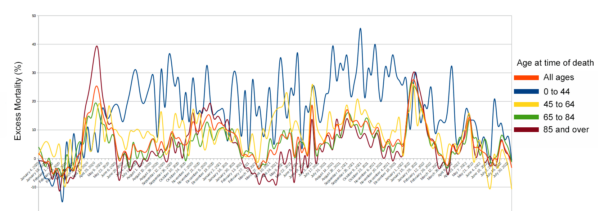How about Autopsies? Of well, Germany did just that and confirmed the impact of the JAB.
The first wave took out the vulnerable and since then we are taking out way more young people. And the kill is so far sustained. This is seriously worrying. A normal shift would be a slight minus number. We were steadily getting better at staying alive.
We continue to watch regulators do everything in their power to ignore completely clear science.
Higher Percentage of Excess Mortality Among Younger Canadians Since Pandemic, but Cause Not Mainly COVID-19
A paramedic is shown next to an ambulance outside a hospital in Montreal on Dec. 28, 2020. (The Canadian Press/Graham Hughes)
By Noé Chartier
December 10, 2022Updated: December 10, 2022
https://www.theepochtimes.com/higher-percentage-of-excess-mortality-among-younger-canadians-since-pandemic-but-cause-not-mainly-covid-19_4915351.html?
While it has been mostly older people with comorbidities who have died from COVID-19 since the start of the pandemic, it has been younger Canadians who have experienced the highest percentage of excess mortality, according to data from Statistics Canada.
Excess mortality takes place when more people die during a given period than normally expected based on trends.
Data provided by Statistics Canada analyzed by The Epoch Times shows that since March 2020, there were on average 7 percent more deaths than expected for all ages.
Meanwhile, for the age group between 0–44 for the same period, there were on average 19 percent more deaths than expected.
The dataset from Statistics Canada only includes the period between January 2020 and early August of this year.
It shows that before March 2020, excess mortality for all age categories except the 45–64 group was negative.
Then during the first wave of the pandemic, excess mortality rose more prominently for ages above 45, peaking at close to 40 percent excess mortality in May 2020 for those over 85.
In late May, after deaths from the first wave receded, excess mortality for the age group 0–44 began rising and became higher than all other age groups.
Chart of excess mortality percentage in Canada from January 2020 to August 2022 based on data from Statistics Canada. (The Epoch Times)
This trend has remained mostly consistent up until the last available data in August, with the monthly excess mortality often reaching over 30 percent.
And whereas excess mortality peaked for all age groups over 45 during the Omicron wave of last winter, there was no discernible spike in the 0–44 category.
In June of this year, Statistics Canada released a report on the excess mortality among younger Canadians for the month of January, and noted very high changes in death data in specific provinces.
For those under 45, there was 35.9 percent excess mortality in Saskatchewan, 51.6 percent in Alberta, and 48.7 percent in British Columbia, the report says. By comparison, excess mortality for those aged 45 and older was 17.6 percent in Saskatchewan, 18.8 percent in Alberta, and 21 percent in British Columbia. The report didn’t include statistics for other provinces.
So what is causing the excess mortality among young people? Statistics Canada said at the time that this data was not yet available, but drug overdoses could be a factor.
Causes of Death
Statistics Canada released a new report on excess mortality on Dec. 8, which again touches on the topic of higher-than-expected deaths among young people.
The report says provisional data indicates there were an estimated 50,443 excess deaths in all ages in Canada from March 2020 to August 2022, which accounts for 7.3 percent excess mortality.
The federal agency says that at least 41,480 of these deaths were directly attributed to COVID-19.
This means there have been 8,963 excess deaths not attributed to COVID-19.
The report notes that when it comes to younger Canadians, other factors beside COVID-19 are mainly responsible for excess deaths.
“By August 2022, those younger than 65 years have accounted for just over 10% of the deaths attributed to COVID-19 but 30% of the excess deaths, suggesting that other factors are driving excess mortality among younger Canadians,” the report says.
Deaths related to alcohol and drug use reached record highs during the pandemic, the report says.
There were 4,605 deaths attributed to accidental poisoning and exposure to noxious substances in 2020 and 6,235 deaths in 2021, says the report, adding that the numbers will increase after the data is revised in the future.
At the height of the overdose crisis in 2017, before the pandemic, 4,830 deaths had been attributed to unintentional poisonings.
The agency says people under 45 account for a “disproportionate” number of deaths from overdoses, at 57 percent. That age group also accounts for 55 percent of the total Canadian population, according to Statistics Canada population estimates from July 2022.
The report also says alcohol-induced mortality increased during the pandemic. In 2019 there were 3,200 alcohol-induced deaths, increasing to 3,790 in 2020 and 3,860 in 2021.
Statistics Canada doesn’t say how many of the 8,963 non-COVID excess deaths could be attributed to drug or alcohol poisoning.
The agency reported in May that there had been a statistically significant increase in suicidal ideation since the pandemic began, from 2.7 percent to 4.2 percent, but suicide is not cited as a potential contributing factor in higher excess mortality for younger people.
A study by the Ottawa Hospital Research Institute suggests there was actually a decrease in the number of suicides during the pandemic. Researcher Dr. Simon Hatcher said it’s possible some suicide deaths could be attributed to the opioid epidemic.
“The number of opioid deaths due to overdoses has increased enormously over the pandemic and it could be that some of the suicide deaths have moved into the opioid deaths,” Hatcher told CTV News in April.
The Epoch Times asked the Public Health Agency of Canada whether it was studying excess mortality in young people, but it deferred to Statistics Canada.
Excess Mortality Across the World
The trend of an increase in excess mortality in young people has been documented in other parts of the world as well.
The United Kingdom’s Office for National Statistics published a report in March on the issue, in a paper entitled “COVID-19 vaccination and mortality in young people during the coronavirus pandemic.”
In 2021 there was excess mortality in England among those aged 15 to 29, the report said, but “there is currently no evidence of a change in the number of cardiac-related deaths or death occurring from any cause after a coronavirus (COVID-19) vaccination in young people aged 12 to 29 years in England.”
The report did say that “the safety of these vaccines is still of concern,” noting an “alleged association between vaccination and mild myocarditis and pericarditis in young people.”
“It is important to investigate potential causes of this excess of death registrations, and consider any possible connection with the vaccination programme,” says the report.
Peer-reviewed studies show links between COVID-19 vaccination-induced myocarditis as a likely cause of death, including an autopsy-based study published in Clinical Research in Cardiology in November, and a study published in Circulation, the journal of the American Heart Association, in August. It found that within a year, 345 people died of myocarditis in England after being vaccinated.
The United States has also seen excess mortality among its younger population. The Epoch Times previously reported that in 2021, approximately 96,000 more prime-age Americans died than in 2018 and 2019, adjusted for population change.
‘Ill-defined and Unknown Cause’
Along with excess mortality in young people, there are other trends in pandemic deaths worthy of attention.
Alberta reported for the first time that deaths from an “ill-defined and unknown cause” became the leading cause of death in 2021, with 3,362 deaths, displacing dementia which led in previous years.
The number of deaths of an “ill-defined and unknown cause” was 1,464 in 2020 and 522 in 2019.
Alberta’s data also shows there was a rise in overdose deaths in 2020 but then a decrease in 2021 to lower than before the pandemic.
In 2019, the province reported 677 deaths due to overdoses, which it calls “accidental poisoning by and exposure to drugs and other biological substances.” The number climbed to 920 in 2020, but then fell to 604 in 2021.


No comments:
Post a Comment